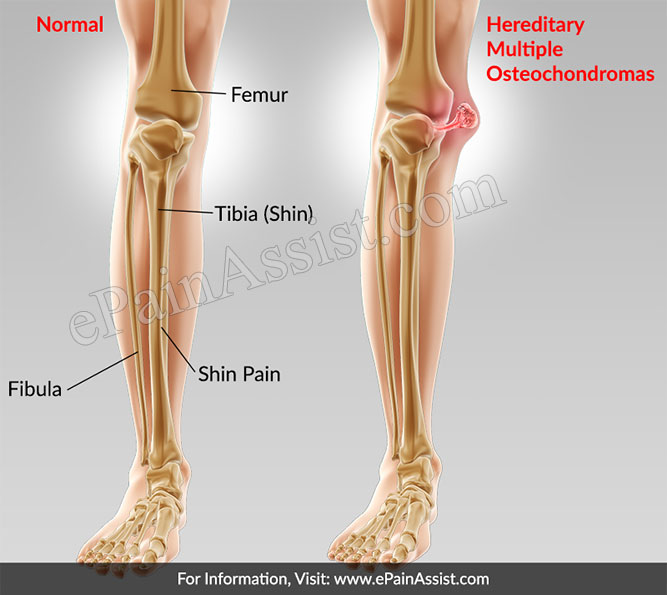What Is Hereditary Multiple Osteochondromas?
Hereditary Multiple Osteochondromas is an extremely rare genetic pathological condition, the characteristics of which include development of benign bone tumors covered with cartilage. These tumors most commonly develop on the metaphysis of the long bones of the lower and upper extremities. Sometimes even the digits are involved in some cases of Hereditary Multiple Osteochondromas.
These lesions continue to grow till the child reaches puberty and may lead to certain musculoskeletal deformities, along with short stature, compression of the nerves and even the range of motion of the affected extremity is decreased. Hereditary Multiple Osteochondromas follows an autosomal dominant pattern of inheritance meaning that only one copy of the defective gene from either parent is good enough for a child to develop it. Mutation in the EXT1 or EXT2 gene is responsible for the development of Hereditary Multiple Osteochondromas.

What Causes Hereditary Multiple Osteochondromas?
As stated, mutation in genes EXT1 or EXT2 is responsible for the development of Hereditary Multiple Osteochondromas. The function of these genes is to suppress tumors. This condition is inherited as an autosomal dominant trait in which only one copy of the defective gene from either parent is good enough for a child to get this condition.
In some cases, there may be de novo mutations or spontaneous mutations in which a child can get this condition with any prior family history of Hereditary Multiple Osteochondromas. It is inherited as an autosomal dominant genetic condition. Dominant genetic disorders occur when only a single copy of an abnormal gene is necessary to cause a particular disease. The abnormal gene can be inherited from either parent or can be the result of a new mutation in the affected individual. Studies suggest that individuals with EXT1 mutations tend to have more symptoms than those with EXT2 mutations of Hereditary Multiple Osteochondromas.
What are the Symptoms of Hereditary Multiple Osteochondromas?
The primary presenting symptom of Hereditary Multiple Osteochondromas is the presence of bone tumors that are covered with cartilage. This leads to skeletal deformities and decreased range of motion of the affected extremity.
These lesions are mostly seen in the metaphysis of t he long bones of the upper and lower extremities. Sometimes, the digits of the upper and lower extremities may also be involved.
The size of the lesions is significantly variable. In some cases, there may be few lumps which may be large while in some cases there may be numerous small lesions as a result of Hereditary Multiple Osteochondromas.
How Is Hereditary Multiple Osteochondromas Diagnosed?
If the child has a family history of Hereditary Multiple Osteochondromas than the diagnosis of this condition becomes easier. A thorough clinical evaluation along with radiographic studies in the form x-ray, MRI or CT scans of the affected area may point towards a diagnosis of it.
Additionally, a molecular testing will clearly show mutations in EXT1 or EXT2 gene which will confirm the diagnosis of it.
What is the Treatment for Hereditary Multiple Osteochondromas?
The front line treatment for Hereditary Multiple Osteochondromas is surgery. This is quite essential for relief of symptoms like pain and decreased range of motion. It also helps in restoring normal circulation through the affected area which tends to get impaired as a result of Hereditary Multiple Osteochondromas. In case if these Osteochondromas become malignant then surgical removal followed by chemotherapy and radiation therapy is required for treatment.
The signs that an individual is having a malignant tumor are pain and an accelerated growth of the tumor. It is essential for children with this condition to have regular screenings done to look for signs of any malignancy and if present prompt treatment should be given so as to remove the malignant lesions that develop as a result of Hereditary Multiple Osteochondromas.
